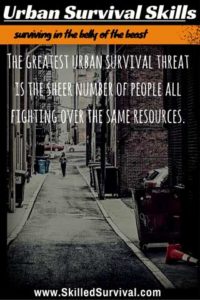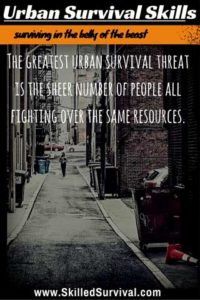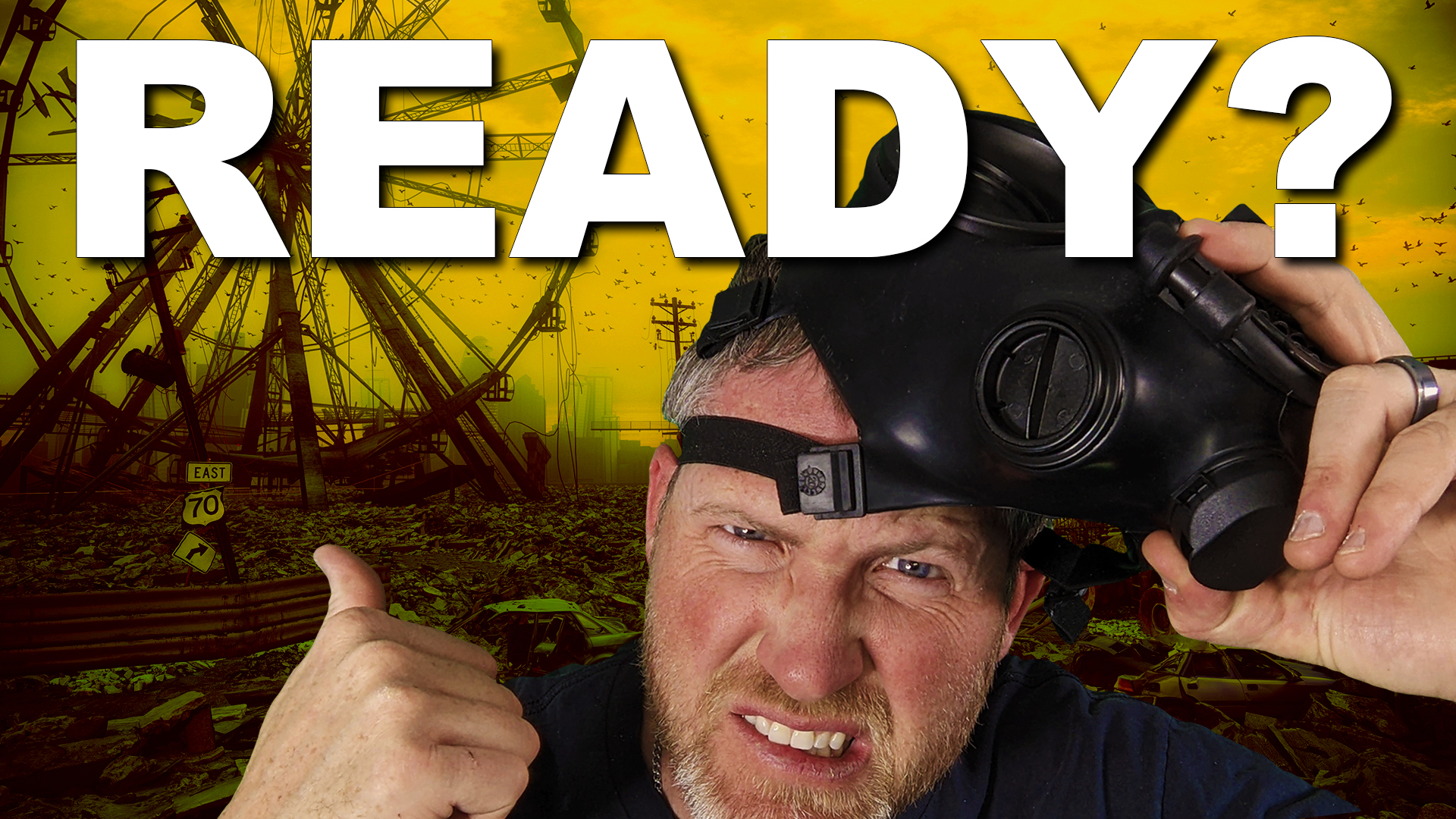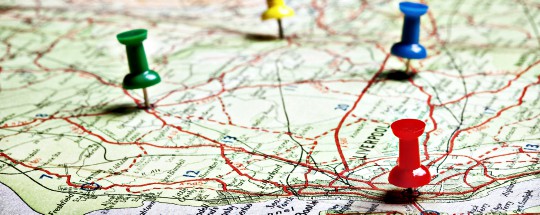
Too many people, living too close together. But that’s why I’ve prepared for it.
Don’t run away from what scares you; stare it down, and get prepared.
So let’s start by agreeing on “What Urban Survival Is” and “What It’s Not”.
The definition of Urban Survival differs slightly depending on who you ask.
Many take it to mean your “day-to-day city survival and safety measures” – a.k.a. “street smarts.”
But for us, I define it as follows:
The skills, tactics and ability to survive a widespread prolonged disaster while remaining in a densely populated urban environment (even if it’s just for a few days).
Urban survival is having the ability to tough it out in the belly of the beast.
Are You Ready For The Tough Times Ahead? Take My 60 Sec Quiz To See If You’re Part Of ‘The Fragile Masses’ Or Not… Start Quiz Now!
Surviving a world-shattering event from within the heart of a dangerous city takes an entirely different mindset. It also takes a particular set of survival skills, tools, and plans to stay alive.
Now, even if you don’t live or work in one of the high-population counties, maybe, you have a family member that does. Or maybe you occasionally visit your kids, friends, or relatives in a nearby high-density city.
The bottom line is this:
If SHTF happens and you live in a city or are just there for a short visit, do you have the urban survival skills and knowledge to hunker down and survive?
Maybe you’re forced to stay for a couple of days or weeks, do you know how to successfully transverse such an environment?
5 Critical Urban Survival Skills to Learn Now
Getting Home
When a disaster strikes, the first thing you’ll want to do is to get home (unless your home was destroyed).
Why? Because if you’ve prepared to any degree, that’s where you’ll be keeping the bulk of our survival gear and resources. But they don’t do you much good unless you can’t get home first.
You should assume you won’t be home when disaster strikes. You might be…but you shouldn’t assume that. This assumption helps you get prepared for that scenario.
And that’s why you need a fully stocked Get Home Bag.
Before you skip this section, hear this first: a GET HOME BAG is very different than a “Bug Out Bag” (BOB).
A BOB tends to be a large backpack, stored at home, and chalked full of almost every necessary piece of survival gear imaginable. It’s used for surviving (mostly in the wild) post-disaster.
Exclusive Bonus Content – Skilled Survival’s 104 Item Bug Out Bag Checklist – the only bug out checklist worth using. Click Here To Get Your FREE Copy Of It.
A “Get Home Bag” by comparison, is small, lightweight, and straightforward. You should have at least one of these but for many, it makes sense to have several dispersed in strategic areas. One for the car, one for the office, one for the boat, one for the RV, etc.
A get home bag should contain a number of specific survival resources to help you get back to home base. Here are the most common items found in a get home bag:
- Spare Cash
- Everyday Carry Knife
- Maps (of the city and surrounding areas)
- Military Compass
- Everyday Carry Flashlight
- Small First Aid Kit
- Hand Crank Radio
- Protein Bars
- Water and Portable Water Filter
- Lockpicking Set
The point of a Get Home Bag is to help you Get Home, duh!
It’s the basic survival gear that will give you a bit of an edge should the world surrounding you fall into chaos when you’re away from your home base.
Get Home Bug Out Bag for Urban Survival
Rendezvous Location Specification
Great now that you’ve got your Get Home Bag, what happens if home base is destroyed or not safe? Do you have a backup rendezvous location? Have you shared this location with your loved ones?
When you are trying to survive an urban emergency, you might not have the opportunity to call your family and friends to arrange a meeting place.
The kids might be at school. Your significant other may be at work across town; you might be at the dentist.
It’s better to plan ahead and specify a rendezvous point. But it has to be somewhere memorable – this does not work if everyone forgets where the meeting place is.
Landmarks, schools, or someone else’s house (you trust) are all possible options.
Make sure everyone is on the same page and even practice a few rendezvous drills at this location.
Deciding to Bunker Down or Bug Out
OK, this is the next big decision you need to make.
The desire to get as far away from the city in a prolonged disaster is natural, but not an urge you should follow in every circumstance.
When you get home, check the news and talk to your neighbors to dig up more information on the situation. There are some considerations to take into account:
What is your emergency food stock looking like? Depending on how much food and water you have stocked up, you may be able to survive at home longer. The better your stockpile, the higher your chances of survival.
How serious is the disaster or emergency? If it’s dangerous and forecasted to continue that way, maybe your best option is to grab your stocked bug out bag and go.
OR, it could be a severe (but temporary) emergency in which case bugging out might be a rash decision.
Are government institutions still functioning? Without police officers, firefights, and paramedics, EMTs things are going to get nasty fast.
Of course, unanticipated things happen all the time – and they tend to occur more frequently during emergencies and disasters. Some unforeseen events may sway your decision. It may force you out of the city, or trap you within your own home; expect the unexpected.
You need to plan and then decide if it makes more sense to bug in or bug out.
Bug-In VS Bug-Out
For A Limited Time – We’re Giving Away Our Most Popular Checklists For FREE!
#104 Item Bug Out Bag Checklist or #78 Item Prepping Checklist
Urban Survival Planning and Preparation
For the sake of the rest of this article, let’s assume you decide it’s best to hunker down.
The real survival threat in an urban setting is the sheer number of people fighting over the same resources. So to survive such an environment we will primarily focus on the following two skills:
- Avoiding Others
- Scavenging Resources
If you can limit your exposure to others and scavenge essential resources, your chances of urban survival go up significantly.
Avoiding Others – Staying Put
Avoiding others will be a real challenge in a dense city, but the easiest way to avoid other people is to stay hidden in your home or apartment. And the only way you’re going to be able to do that for an extended period of time is to stockpile.
I won’t go into extreme detail here about stockpiling (you can read more about it here), but basically, you need to stock food, water, medical supplies, etc.
A note of caution: Don’t tell your neighbors or even friends about your stockpile. Unless you’re OK with sharing your stock resources when SHTF.
So limiting the amount of exposure to others by hunkering down is a good first step. But if you’re dealing with a prolonged disaster, at some point you’ll be forced to venture out for replenishment.
Avoiding Others – Urban Transportation
Naturally, if you jump in your car, start her up, and put the pedal to the metal you’ll be noticed by others.
But more often than not, in serious emergencies roads will be jammed up anyways. This can be a serious obstacle for someone determined to get back to home base or trying to move about the city.
Cars and trucks are the hardest to get around in the midst of chaos. Motorcycles and scooters are more nimble and can dart/weave through thick traffic and tight roadways.
Bicycles are another quick way of getting around in an emergency – they are particularly handy in the case of an EMP because they do not require any electrical input to get you from point A to point B.
However, with all of these options, you are highly exposed. Exposed to gangs, thieves, or a looter who all may have gunfire.
So evasion is paramount when exposure becomes risky.
Urban Survival: Improvised Shelter During SHTF
Going by foot is preferred once cars, scooters, and bikes become a liability because you can move quietly, and efficiently without the need for roads.
Unfortunately, many large cities sprawl which means that you could have a very long distance to cover. Miles could take days if remaining hidden is required.
Darting through small buildings, a basement, or rooms to provide hidden paths can work, however, if you don’t know the city well you may be evading right into a bad guy’s lair.
Cities simply have too many people in them to remain undetected for the long haul. So you also need to have a self-defense plan and be ready to take immediate proactive action.
Firearms are loud but effective so equip yourself with a suppressor. Melee weapons are quieter but less efficient.
I plan to have both options with me at all times and use the one that seems most appropriate for any given situation.
Exclusive Bonus Content – Skilled Survival’s 104 Item Bug Out Bag Checklist – the only bug out checklist worth using. Click Here To Get Your FREE Copy Of It.
Get To Know Your Area Well and Practice
People who live and work in urban environments should know their area intimately.
Take multiple different routes to and from work each day to explore new areas and find back alleys and shortcuts.
Buy some detailed maps of the city and surrounding areas (keep these in your Get Home Bag). Study these maps. Learn them now so you’re not fumbling with them later when the lights go out, and anarchy breaks loose in the city.
Urban survival includes learning how to move about a city undetected; like a ninja. Traveling over rooftops or sewer systems becomes a major advantage.
These are routes you should start practicing today to move secretly throughout a city.
Here’s a video that provides several excellent ideas on how to travel and scavenge in an urban survival situation.
US Marine shows how to survive in an urban environment
Scavenging For Resources
As we just discussed, moving about undetected is key to avoiding conflict. But where are you going and why? You’re scavenging.
Finding useful resources in an urban environment may seem like a simple process. Just dart off to the nearest Walmart or Target, right? The problem with these public locations is that they are obvious.
Everyone already knows about these locations and they will be looted early in a disaster. So you need some new ideas. Some good locations where the masses won’t be looking (at least initially).
You want to focus on places that the masses have never thought about. Places such as distribution centers, manufacturing sites, schools, or building construction sites.
Your odds of scoring a few precious resources go up significantly if the masses haven’t been there yet. The main resources you’re going to want are:
- Water
- Food
- Medical Supplies
- Tools and Gear (such as lockpicking)
Also, if you’re a skilled survivalist, you’ll know how to turn what looks like junk into a useful survival item. So keep that in mind when scavenging.
The following two videos provide several examples of less well-known urban survival locations that you’ll want to focus your scavenging efforts on.
After the Collapse: 10 Urban Survival Strategies (Part 1)
<iframe loading="lazy" title="After the Collapse:10 Urban Survival Strategies (Part 1)







